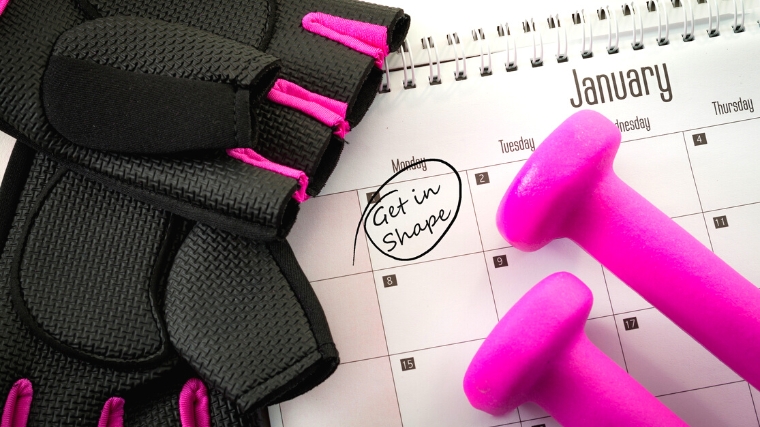
Six Science-Backed Tips to Stick to Your New Year’s Fitness Resolution
The fittest people on the planet once struggled with their first push-up. No one is born in pristine physical condition; they’ve committed to getting themselves there. If you’ve decided to take the plunge and make this year your fittest yet, congratulations! As you’ll see, getting started is, quite literally, half the battle.
But once you’ve started, you have to stick to it. You may be riding a resolution high at the moment, but how do you fuel that fire for the rest of the year — or the rest of your life? You need actionable, evidence-based tips to fall back on.

Here are six tips for adhering to a fitness-based New Year’s resolution, and how you can get the most out of every drop of sweat you shed along the way.
How to Stick to Your New Year’s Fitness Resolution
Set the Right Goals
Your goals or resolutions should be specific, clear, actionable, and, above all, laid out in a proper hierarchy. Well-defined goals will paint a better picture of your destination than vague or nebulous ones. Moreover, establishing a goal hierarchy lets you know where to direct your efforts on a day-to-day basis.

Think of goal setting like building a house. You need a strong foundation; a base of support, a mission statement. Once you have that, you layer on top of it several smaller and more precise objectives. Your goal hierarchy should look something like this:
- Superordinate Goal
- Intermediate Goal
- Subordinate Goal
The Science
Evidence indicates that goal organization is a critical component of achieving success, both in and out of the weight room. (1)(2) It would do you little good to simply cast your intent out into the universe and hope for the best. Much like a well-designed workout program, your fitness goals should be periodized as well.
Your superordinate goal is your broad-spectrum objective, such as improving your health. Below that, you should have several clear intermediate goals; the behaviors that contribute toward your health-related resolution. Below that lie your subordinate goals — these are the specific behaviors you’ll enact in service of your larger goals.

Research supports this kind of organizational process as an effective means of adhering to your goal or resolution. In real-world terms, this kind of organizational hierarchy could look something like this:
- Superordinate Goal: I want to improve my health.
- Intermediate Goal: I will exercise more to improve my health.
- Intermediate Goal: I will eat better to improve my health.
- Intermediate Goal: I will take adequate rest to improve my health.
- Subordinate Goal: I will go to bed at a reasonable hour each night.
- Subordinate Goal: I will limit screen exposure to a certain number of hours per day.
- Subordinate Goal: I will avoid checking my work e-mail outside of standard working hours when able.
Make a Positive Plan
You should strive to have a positive relationship with whatever goals you’ve set for yourself. Goal-directed behavior is much more complex than “I want this, so I’m going to go get it.” When it comes to altering your behaviors and habits, your brain can be a powerful ally or a frustrating nuisance.

Whenever possible, put a positive spin on whatever goal you’ve set for yourself. Your internal monologue, as well as how you approach self-talk, can impact the outcome of your efforts far more than you think. If you have a negative or avoidance-oriented mindset, you may inadvertently hamstring yourself before you even get underway.
The Science
When delving into the psychology behind goal setting, some researchers have discerned a clear divide between two types of goal “categories” — approach goals and avoidance goals. (3)(4)
If you frame your fitness resolution in avoidant terms, you may be less likely to actually achieve the change you’re after. For example, framing a nutritionally-based behavior change as, “I must stop eating junk food,” while well-intentioned, may be more detrimental than helpful. Avoidant behaviors and negative phrasing can create undue psychological stress and, according to some research, deter you from staying on track with the change in the first place.

Instead, strive to frame your changes in an approach-oriented manner. Which is to say, simply, put a positive spin on things. Instead of framing your resolution as something negative that you’ll stop, approach it as a new behavior that you’ll start.
Research backs the power of small adjustments like this. Your internal narrative is extremely potent, whether you realize it or not, and you should respect the leverage your mind can have over your actions.
Change Your Environment
Your fitness resolution started in your mind, so it makes perfect sense to develop a positive, goal-oriented mental framework around gaining some muscle, losing a bit of fat, or adjusting your dietary habits.
Your physical environment matters just as much. It can impact how well you adhere to your goals, or deter you from staying on track altogether. As such, you should curate your physical environment such that obstacles or temptations are removed, and assistance is made readily available.
The Science
When it comes to habit adherence, research indicates that your environment plays a significant role in how well you stay on the ball about things like eating well or exercising regularly. (5) Don’t worry, you don’t need to drag your mattress into the weight room and literally live in the gym if your resolution is to get in better shape.

However, some sensible, tactical changes to your living situation can go a long way. If you’re trying to eat healthier this year and snack less often, the best way to remove temptation is to not purchase too many high-calorie treats in the first place. Or, store them in a cabinet or pantry out of sight. Make them inconvenient to consume on a whim, and, instead, keep healthful alternatives out in plain sight.
When it comes to exercise, you can set yourself up for success from the moment you get out of bed: Placing your phone or alarm clock on the far side of the bedroom will force you to physically get up to shut it off, which can make it easier to get going in the early hours. Similarly, you can set out your workout clothing ahead of time or pack your gym bag the night before.
Small changes like these add up and can help you build the momentum required to stay on track with a new health-related habit. Create an environment conducive to change, and you’ll find it much easier to stay on-program.
Be Flexible
The shortest distance between two points may be a straight line, but your fitness journey is a winding road riddled with obstacles to overcome and barriers to smash through. You’re likely to make pit stops along the way or stray from the path entirely from time to time.
To get where you want to go with your health or personal fitness, you should be flexible about the route you take and the speed at which you travel. Be prepared to accommodate unforeseen circumstances, make adjustments on the fly, or give yourself a break entirely.

This applies to your nutritional habits as much as it does the cadence and frequency of your workouts. Slip-ups are natural and happen to everyone — when it comes to goal-directed behavior, what matters is how you react and adapt to them.
The Science
Regarding nutrition and dietary practices, most contemporary research acknowledges the dichotomy between what’s called rigid versus flexible restraint. (6) This paradigm centers mainly around how bodybuilders and other fitness-minded folk approach their eating habits, but the logic applies to motivation and goal-related behaviors of all sorts.
Put simply, the science indicates that flexible restraint — dietary or otherwise — is a more effective long-term strategy than rigid restraint. The former permits occasional lapses in adherence as well as a fluid approach to your actions and choices, while the latter flatly categorizes behaviors as either permissible or impermissible; “right” or “wrong.”
So, say you have a New Year’s resolution of exercising in the gym three times per week, but, for whatever reason, you can’t make it to the weight room for your second session. Instead of throwing in the towel altogether, you could hit up a quick bodyweight-only workout at home.
A similar idea backs the practice of flexible dieting. If you have a diet-related resolution you’re trying to stick to, don’t beat yourself up for the once-in-a-while indulgence. In fact, many of your favorite foods can fit nicely into the context of a health-oriented diet as a whole.
No matter what your resolution is, be prepared to adapt and adjust as necessary. You’ll have a better chance of success if you’re willing to embrace flexibility as a core tenet.
Hit the Weights
If your New Year’s resolution involves hitting the weights on a regular basis, great. If not, you should consider making resistance training at least a portion of your overall fitness regime. This doesn’t necessarily mean you have to become a full-time, stringer-tank-clad, clanging and banging gym rat — but regular strength training can do a lot for your overall fitness goals.

Not only does weight training improve various aspects of your physical health such as muscular strength and tone, bone density, metabolic efficiency, and more, but it may also help you psychologically.
The Science
Emergent research has illustrated a compelling relationship between weight training and what clinicians call “executive function,” which, according to Harvard University’s department of childhood research, refers to “the mental processes that enable us to plan, focus attention, remember instructions, and juggle multiple tasks successfully.” (7)(8)
Specifically, some of this new research has displayed a marked improvement in acute self-control in the hours following a weight training session, in addition to the already well-documented improvements in general cognition.
So, if lifting weights isn’t part of your resolution in some way, it probably should be. If it is, consider training at specific times. A lunch-hour lifting session may compel you to make healthier food choices at lunch, for instance, rather than hitting up the drive-thru. Or, you can smash a lifting workout early in the morning and reap the benefits for the rest of the workday.
Take the Plunge
It may seem obvious, but in order to achieve your New Year’s resolution(s), you have to begin working towards them in the first place. But the psychology behind goal-directed behavior goes even deeper than that.

Paralysis by analysis is a real thing, and can stymie you in a sludge of uncertainty, second-guessing, and self-doubt. It’s quite common for people to have the intent to make a behavior change, but wait endlessly for the perfect climate to do so. And, unfortunately, that time never comes.
If you’re on the fence about taking the plunge into a fitness-oriented goal, don’t sit around waiting for the exact right circumstances. An imperfect beginning is still a beginning, and setting the gears in motion is more important than you think.
The Science
Investigations into the habit-forming processes of health psychology have returned some surprising findings. Specifically, some literature discusses that habitual instigation — literally, beginning an action in accordance with a health-related goal — is even more relevant as a success metric than habitual execution, or completing said action. (9)
The reasoning isn’t crystal clear, but it may have to do with a phenomenon of positive momentum and self-efficacy. Oftentimes, breaking inertia is the most difficult part of any process (health-related or otherwise).
So, if you’re still on the fence about starting, it’s time to hop off and get to work. Your efforts don’t have to be perfect; very few people have pristine squat technique when they put the bar on their back for the first time. What matters is that you initiate the action.
Sample Workout Programs
Committing to a fitness goal is like planning a road trip. Sure, you might know where you want to end up. But how do you get there? You need the right vehicle that can go the distance — the right training plan.
Luckily, BarBend has plenty of evidence-based training programs designed to help you smash your goals in the new year. Here are just a few that might be of use to you:
Ever Forward
Sticking to a fitness resolution is easier said than done. It requires diligence, discipline, and determination. Having an assortment of well-thought-out goals can help you stay on track. They also provide you with a barometer against which you can measure your efforts. This can provide some much-needed encouragement and inspiration to keep pushing forward.
If you’re still in the process of mapping out your New Year’s resolutions, this guide should help you paint a clearer picture of what you want to achieve with your health. If you’ve already decided on a destination, great. You have miles to go before you rest, though, so keep your foot on the gas.
References
- Oscarsson, M., Carlbring, P., Andersson, G., & Rozental, A. (2020). A large-scale experiment on New Year’s resolutions: Approach-oriented goals are more successful than avoidance-oriented goals. PloS one, 15(12), e0234097.
- Höchli Bettina, Brügger Adrian, Messner Claude. (2018) How Focusing on Superordinate Goals Motivates Broad, Long-Term Goal Pursuit: A Theoretical Perspective. Frontiers in Psychology, 9.
- Bailey R. R. (2017). Goal Setting and Action Planning for Health Behavior Change. American journal of lifestyle medicine, 13(6), 615–618.
- Coats, E. J., Janoff-Bulman, R., & Alpert, N. (1996). Approach Versus Avoidance Goals: Differences in Self-Evaluation and Well-Being. Personality and Social Psychology Bulletin, 22(10), 1057–1067.
- Wood, W., Tam, L., & Witt, M. G. (2005). Changing circumstances, disrupting habits. Journal of personality and social psychology, 88(6), 918–933.
- Helms, E. R., Prnjak, K., & Linardon, J. (2019). Towards a Sustainable Nutrition Paradigm in Physique Sport: A Narrative Review. Sports (Basel, Switzerland), 7(7), 172.
- Huang, T. Y., Chen, F. T., Li, R. H., Hillman, C. H., Cline, T. L., Chu, C. H., Hung, T. M., & Chang, Y. K. (2022). Effects of Acute Resistance Exercise on Executive Function: A Systematic Review of the Moderating Role of Intensity and Executive Function Domain. Sports medicine – open, 8(1), 141.
- Executive Function & Self-regulation. Center on the Developing Child at Harvard University. (2020, March 24).
- Gardner, B., Phillips, L. A., & Judah, G. (2016). Habitual instigation and habitual execution: Definition, measurement, and effects on behaviour frequency. British journal of health psychology, 21(3), 613–630.
Featured Image: ME Image / Shutterstock





